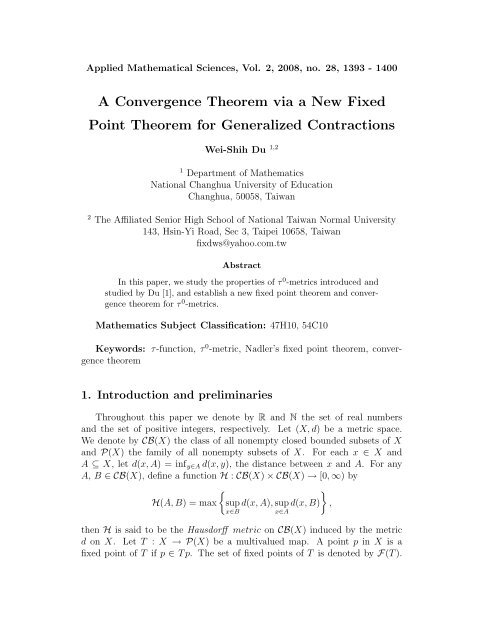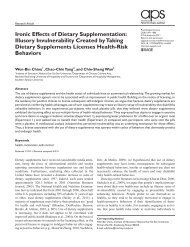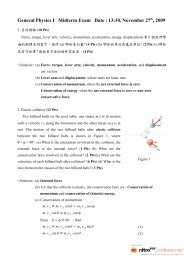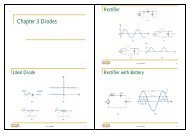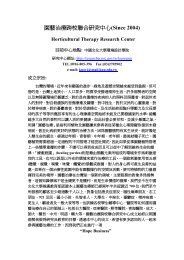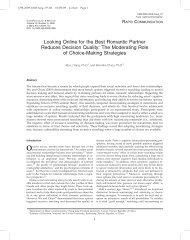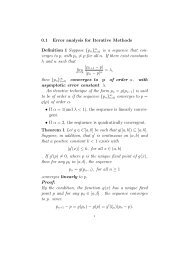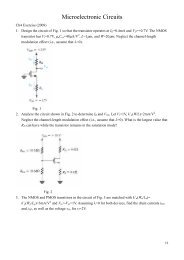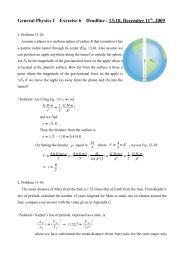A Convergence Theorem via a New Fixed Point Theorem for ...
A Convergence Theorem via a New Fixed Point Theorem for ...
A Convergence Theorem via a New Fixed Point Theorem for ...
You also want an ePaper? Increase the reach of your titles
YUMPU automatically turns print PDFs into web optimized ePapers that Google loves.
Applied Mathematical Sciences, Vol. 2, 2008, no. 28, 1393 - 1400<br />
A <strong>Convergence</strong> <strong>Theorem</strong> <strong>via</strong> a <strong>New</strong> <strong>Fixed</strong><br />
<strong>Point</strong> <strong>Theorem</strong> <strong>for</strong> Generalized Contractions<br />
Wei-Shih Du 1,2<br />
1 Department of Mathematics<br />
National Changhua University of Education<br />
Changhua, 50058, Taiwan<br />
2 The Affiliated Senior High School of National Taiwan Normal University<br />
143, Hsin-Yi Road, Sec 3, Taipei 10658, Taiwan<br />
fixdws@yahoo.com.tw<br />
Abstract<br />
In this paper, we study the properties of τ 0 -metrics introduced and<br />
studied by Du [1], and establish a new fixed point theorem and convergence<br />
theorem <strong>for</strong> τ 0 -metrics.<br />
Mathematics Subject Classification: 47H10, 54C10<br />
Keywords: τ-function, τ 0 -metric, Nadler’s fixed point theorem, convergence<br />
theorem<br />
1. Introduction and preliminaries<br />
Throughout this paper we denote by R and N the set of real numbers<br />
and the set of positive integers, respectively. Let (X, d) be a metric space.<br />
We denote by CB(X) the class of all nonempty closed bounded subsets of X<br />
and P(X) the family of all nonempty subsets of X. For each x ∈ X and<br />
A ⊆ X, let d(x, A) = inf y∈A d(x, y), the distance between x and A. For any<br />
A, B ∈CB(X), define a function H : CB(X) ×CB(X) → [0, ∞) by<br />
{<br />
}<br />
H(A, B) = max sup d(x, A), sup d(x, B) ,<br />
x∈B<br />
x∈A<br />
then H is said to be the Hausdorff metric on CB(X) induced by the metric<br />
d on X. Let T : X →P(X) be a multivalued map. A point p in X is a<br />
fixed point of T if p ∈ Tp. The set of fixed points of T is denoted by F(T ).
1394 Wei-Shih Du<br />
A multivalued map T from X into CB(X) is said to be k-contractive if there<br />
exists a nonnegative real number k with k 0, then p(x, y) ≤ M;<br />
(τ3) For any sequence {x n } in X with lim n→∞ sup{p(x n ,x m ):m>n} =0,if<br />
there exists a sequence {y n } in X such that lim n→∞ p(x n ,y n ) = 0, then<br />
lim n→∞ d(x n ,y n )=0;<br />
(τ4) For x, y, z ∈ X, p(x, y) = 0 and p(x, z) = 0 imply y = z.<br />
It is known that any w-distance [2] is a τ-function; see [4, Remark 2.1].<br />
Let p : X × X → [0, ∞) beaτ-function. For each x ∈ X and A ⊆ X, let<br />
p(x, A) = inf y∈A p(x, y). If A ∈CB(X), then the (p, δ)-neighborhood A (p,δ) of<br />
A is defined by A (p,δ) = {x ∈ X : p(x, A)
<strong>Convergence</strong> theorem 1395<br />
Lemma 2.2. [1] Let A be a closed subset of a metric space (X, d) and<br />
p : X × X → [0, ∞) be any function. Suppose that p satisfies (τ3) and there<br />
exists u ∈ X such that p(u, u) = 0. Then p(u, A) =0if and only if u ∈ A.<br />
From Lemma 2.2 and the definition of τ 0 -function, we obtain the following<br />
property.<br />
Lemma 2.3. Let (X, d) be a metric space and p be a τ 0 -function. For any<br />
A, B ∈CB(X), define δ p (A, B) = sup x∈A p(x, B). Then <strong>for</strong> A, B, C ∈CB(X),<br />
the following hold:<br />
(i) δ p (A, B) =0⇐⇒ A ⊆ B;<br />
(ii) δ p (A, B) ≤ δ p (A, C)+δ p (C, B);<br />
(iii) if A ⊆ B, then δ p (A, C) ≤ δ p (B,C);<br />
(iv) if B ⊆ C, then δ p (A, C) ≤ δ p (A, B);<br />
(v) δ p (A, B ∩ C) ≥ max{δ p (A, B),δ p (A, C)};<br />
(vi) δ p (A, B ∪ C) ≤ min{δ p (A, B),δ p (A, C)};<br />
(vii) δ p (A ∩ B,C) ≤ min{δ p (A, C),δ p (B,C)};<br />
(viii) δ p (A ∪ B,C) = max{δ p (A, C),δ p (B,C)}.<br />
Proof. We first prove (i). If δ p (A, B) = 0 then p(a, B) = 0 <strong>for</strong> all a ∈ A.<br />
By Lemma 2.2, we have A ⊆ B. Conversely, if A ⊆ B, then δ p (A, B) =0by<br />
Lemma 2.2 again. There<strong>for</strong>e δ p (A, B) =0⇐⇒ A ⊆ B. The proofs of (ii),<br />
(iii) and (iv) are straightfoward. Using (iii) and (iv), it is easy to verify that<br />
the conclusions of (v), (vi) and (vii) hold. To show (viii), since A ⊆ A ∪ B<br />
and B ⊆ A ∪ B, using (iii), we have max{δ p (A, C),δ p (B,C)} ≤δ p (A ∪ B,C).<br />
Conversely, given ε>0, there exists u ∈ A ∪ B such that δ p (A ∪ B,C) <<br />
p(u, C) +ε. Then δ p (A ∪ B,C) < max{δ p (A, C),δ p (B,C)} + ε. Since ε is<br />
arbitrary, we obtain δ p (A ∪ B,C) ≤ max{δ p (A, C),δ p (B,C)} and hence (viii)<br />
holds.<br />
✷<br />
Definition 2.2. [1] Let (X, d) be a metric space and p be a τ 0 -function.<br />
For any A, B ∈CB(X), define a function D p : CB(X) ×CB(X) → [0, ∞) by<br />
D p (A, B) = max{δ p (A, B),δ p (B,A)},<br />
where δ p (A, B) = sup x∈A p(x, B), then D p is said to be the τ 0 -metric on CB(X)<br />
induced by p.<br />
Clearly, any Hausdorff metric is a τ 0 -metric, but the reverse is not true.
1396 Wei-Shih Du<br />
The following theorem is one of the main results in [1].<br />
<strong>Theorem</strong> 2.1. [1]<br />
CB(X).<br />
Every τ 0 -metric D p defined as in Def. 2.2 is a metric on<br />
<strong>Theorem</strong> 2.2. Let (X, d) be a metric space and D p be a τ 0 -metric on CB(X)<br />
induced by a τ 0 -function p. Then <strong>for</strong> any A, B ∈CB(X),<br />
D p (A, B) = sup |p(x, A) − p(x, B)|<br />
x∈X<br />
= inf{δ >0:A ⊆ B (p,δ) ,B ⊆ A (p,δ) }.<br />
Proof. It is easy to verify that the conclusion follows from Lemma 2.2 and<br />
Lemma 2.3, so we omit the proof.<br />
✷<br />
Applying Lemma 2.3, we can easy prove the following theorem.<br />
<strong>Theorem</strong> 2.3. Let (X, d) be a metric space and D p be a τ 0 -metric on CB(X)<br />
induced by a τ 0 -function p. Then <strong>for</strong> any A, B, C, D ∈CB(X), D p (A∪B,C ∪<br />
D) ≤ max{D p (A, C),D p (B,D)}.<br />
3. A new fixed point theorem and convergence theorem<br />
Definition 3.1. A multivalued map T : X →CB(X) is said to be (τ 0 ,k)-<br />
contractive or a (τ 0 ,k)-contraction if there exists a constant 0 ≤ k
<strong>Convergence</strong> theorem 1397<br />
Proof. Without loss of generality, we only prove F(T 1 ) ≠ ∅. Let λ ∈ (k, 1).<br />
Take x 0 ∈ X and x 1 ∈ T 1 x 0 .If p(x 0 ,x 1 ) = 0, since p(x 0 ,x 0 ) = 0, by (τ4), we<br />
have x 0 = x 1 ∈ T 1 x 0 .Sox 0 ∈F(T 1 ). If p(x 0 ,x 1 ) > 0, since<br />
p(x 1 ,T 1 x 1 ) ≤ D p (T 1 x 0 ,T 1 x 1 )
1398 Wei-Shih Du<br />
there exists u 2 ∈ T 2 u 1 such that p(u 1 ,u 2 )
<strong>Convergence</strong> theorem 1399<br />
Since ε is arbitrary, we have p(u 0 , ˆv) ≤ . Note that u 1−k 0 ∈F(T 1 ) is arbitrary,<br />
it follows that sup x∈F(T1 ) p(x, F(T 2 )) ≤<br />
γ . Similarly, <strong>for</strong> any ζ 1−k 0 ∈F(T 2 ),<br />
following the same argument, there exists ẑ ∈F(T 1 ) such that p(ζ 0 , ẑ) ≤<br />
γ . 1−k<br />
Also it implies that sup x∈F(T2 ) p(x, F(T 1 )) ≤ . There<strong>for</strong>e we obtain that<br />
γ<br />
γ<br />
1−k<br />
D(F(T 1 ), F(T 2 )) = max{ sup<br />
x∈F(T 1 )<br />
p(x, F(T 2 )), sup<br />
≤<br />
1<br />
1 − k sup D p (T 1 (x), T 2 (x)).<br />
x∈X<br />
x∈F(T 2 )<br />
p(x, F(T 1 ))}<br />
This completes the proof.<br />
✷<br />
Corollary 3.1. (Nadler [6]) Let (X, d) be a complete metric space and<br />
T : X →CB(X) beak-contraction. Then T has a fixed point in X.<br />
The following conclusion is the well-known Banach contraction principle.<br />
Corollary 3.2. [6] Let (X, d) be a complete metric space and T : X → X<br />
be a k-contraction. Then T has a unique fixed point in X.<br />
Corollary 3.3. [3] Let (X, d) be a complete metric space. If T 1 and T 2 are<br />
k-contractive multivalued maps from X into CB(X), then<br />
H(F(T 1 ), F(T 2 )) ≤ 1<br />
1 − k sup H(T 1 (x), T 2 (x)).<br />
x∈X<br />
Applying <strong>Theorem</strong> 3.1, we obtain the following convergence theorem.<br />
<strong>Theorem</strong> 3.2. Let (X, d) be a complete metric space and D p be a τ 0 -metric<br />
on CB(X) induced by a τ 0 -function p. For each i ∈ N ∪{0}, suppose that T i<br />
is a (τ 0 ,k)-contractive multivalued map from X into CB(X) such that p(x, ·)<br />
is l.s.c. <strong>for</strong> all x ∈F(T i ) and lim n→∞ D p (T n (x), T 0 (x)) = 0 uni<strong>for</strong>mly <strong>for</strong> all<br />
x ∈ X. Then lim n→∞ D p (F(T n ), F(T 0 )) = 0.<br />
Proof. Given ε>0. Since lim n→∞ D p (T n (x), T 0 (x)) = 0 uni<strong>for</strong>mly <strong>for</strong> all<br />
x ∈ X, there exists n 0 ∈ N such that sup x∈X D p (T n (x), T 0 (x)) < (1 − k)ε <strong>for</strong><br />
all n ≥ n 0 . By <strong>Theorem</strong> 3.1,<br />
D p (F(T n ), F(T 0 )) ≤ 1<br />
1 − k sup D p (T n (x), T 0 (x))
1400 Wei-Shih Du<br />
References<br />
[1] W.S. Du, <strong>Fixed</strong> point theorems <strong>for</strong> generalized Hausdorff metrics, submitted.<br />
[2] O. Kada, T. Suzuki, W. Takahashi, Nonconvex minimization theorems<br />
and fixed point theorems in complete metric spaces, Math. Japon., 44<br />
(1996), 381-391.<br />
[3] T.C. Lim, On fixed point stability <strong>for</strong> set-valued contractive mappings<br />
with applications to generalized differential equations, J. Math. Anal.<br />
Appl. 110 (1985), 436-441.<br />
[4] L.J. Lin, W.S. Du, Ekeland’s variational principle, minimax theorems<br />
and existence of nonconvex equilibria in complete metric spaces, J. Math.<br />
Anal. Appl. 323 (2006), 360-370.<br />
[5] L.J. Lin, W.S. Du, On maximal element theorems, variants of Ekeland’s<br />
variational principle and their applications, Nonlinear Anal. 68 (2008),<br />
1246-1262.<br />
[6] S.B. Nadler, Jr., Multi-valued contraction mappings, Pacific J. Math. 30<br />
(1969) 475-488.<br />
Received: February 16, 2008


